A glowing report about the Rebels to promoter Harry M. Miller from the show’s Australian road manager, Ron Blackmore, saw them added to the bill for the upcoming 1967 Easybeats tour of Australia. Anticipation was high: it was the Easybeats’ first visit home after their worldwide success with ‘Friday On My Mind’.
After finishing work on their album and several nights of farewell appearances, Larry’s Rebels left for a six-week stint in Australia on April 29. The group’s flight to Melbourne had a two-hour stopover in Sydney, where their reputation had preceded them. They were greeted by journalists and a TV news crew along with members of the newly formed Australian Larry’s Rebels fan club, who made themselves seen and heard.

1968 Impact publicity shot. Another photo from the same photo shoot was used on the cover of the Christmas EP.
On arrival at Melbourne they were met by Ron Blackmore, who was to be their manager and minder in Australia. Ron was accompanied by his father, affectionately known as “Pop” who would be their driver. If the group were looking to ease themselves into their Australian workload then they were in for a shock: Ron announced that they had a gig that night at a Sydney university club.
Off they all headed to the cargo depot to pick up their gear, which had been shipped a week before – only to find that everything was still sitting in Auckland.
For a few minutes there was a sigh of relief as the group thought they might get the night off, only for the ever-resourceful Ron Blackmore to arrange for the group to use The Loved Ones’ gear. During their first week in Melbourne the Rebels appeared on the nationwide TV pop shows Go and Kommotion and eased themselves into the local scene by working at three venues a night. It was a good start in a congested Melbourne music scene where there were over 250 bands competing for work.
The Easybeats’ homecoming tour was a whirlwind six day, eight-concert tour encompassing four cities. Larry’s Rebels were to open the show and back five separate solo singers, who each performed seven songs. The solo artists varied from city to city, except for Ronnie Burns.
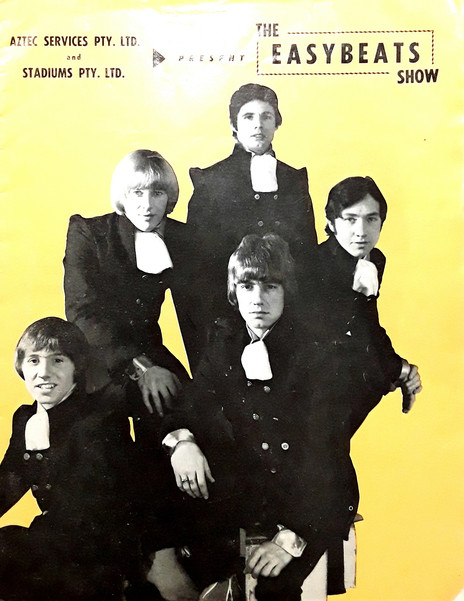
The Easybeats' Australian tour programme, 1967. - Grant Gillanders Collection
There was a certain amount of consternation from the local press around the choice of the virtually unknown Larry’s Rebels on such a prestigious event. Everybody magazine sarcastically commented, “They have swung the tour solely on the strength of a few tapes and photographs.”
The Rebels quickly established themselves on tour and going by the reviews certainly held their own amongst the cream of Australian pop royalty, whereas the Easybeats struggled throughout the tour. After the first show at the Sydney Town Hall, the Sydney Advertiser suggested that the show be called the Twilights Show or the Ronnie Burns Show, anything other than the Easybeats Show.
The review went on to describe the stage invasion by fans when Larry’s Rebels started their bracket. “Ronnie Burns was refreshing and vibrant despite being distracted when ushers intervened to stop a group of fans from approaching the stage. The ushers were not fast enough, however, with a group of fans who dragged Larry Morris from the stage. Morris continued to sing his number – appropriately ‘Release Me’ – while the fans used him for a short game of stacks on the mill.”
Brian Sommerville (former publicity agent for the Beatles) was on the tour as the Easybeats’ publicist and proclaimed Larry’s Rebels to be “the most sensational group that he had seen since leaving the UK”.
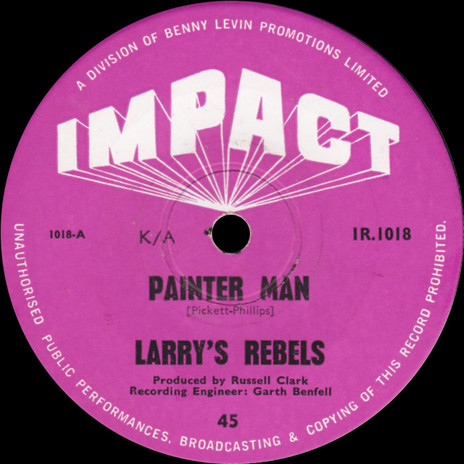
Larry's Rebels - Painter Man (Impact, 1967)
Meanwhile back home, ‘Painter Man’ had been released and quickly debuted on the New Zealand Top 20 on May 18, becoming Larry’s Rebels’ first national hit, eventually reaching No.6 before the single was banned by NZBC radio stations on the strength of one complaint from a “vigilant lady listener”.
In fact, it was moral activist Patricia Bartlett who, like the Rebels, was also at the start of her career. Bartlett claimed Larry’s pronunciation of the lyric “tin can” sounded like “shit can”, which it does. The complaint was upheld but had no real impact as the record had already peaked on the charts. The nationwide publicity was priceless.
Larry’s Rebels returned home for a few days on the 1st of June for a series of Radio Hauraki sponsored jamborees. The group arrived at Auckland Airport to a throng of placard waving fans at 8.30pm and were quickly whisked away to a waiting car by private security officers. Arriving at the car at the same time were 30 female fans, who attempted to rock the car and climb onto the roof. They soon lost interest as the car drove off to the Papatoetoe Town Hall for an 11pm gig.
With demand for the group snowballing, it soon became apparent that the planned two-day whirlwind visit home would not suffice. The group ended up staying for two weeks, while in Sydney their previous single ‘I Feel Good’ had entered the Sydney 2UE Top 20 – possibly a missed chance, but they couldn’t be in two places at once.
The Radio Hauraki Jamboree became a mini-tour of the top half of the North Island, which encompassed the station’s frequency range. Also included on the Jamboree bill were Mr Lee Grant, the Clevedonaires, Ray Woolf & The Avengers, the Sounds and The Chicks.
According to the Rebels, Mr Lee Grant’s manager Dianne Cadwallader took an instant dislike to them. The Rebels responded to Dianne’s negative reaction by making the tour an absolute misery for her and unfortunately, Lee ended up as collateral damage on more than one occasion.
John Williams: “In retaliation for being treated as lepers I decided to play a bum note in the intro to Lee’s showstopper torch ballad, ‘Maria’, which totally put him off his stride and boy did we hear about that ad nauseum for the next few days.”
It didn’t end there either, as Larry recounts: “One night after the show when Dianne wasn’t circling around we got Lee drunk and when he passed out we stripped him off, bundled him into a portable cot and locked him outside on the balcony of his room. Dianne eventually found him just as he was starting to turn blue.”
The more Dianne complained to management the more the boys retaliated, with a whole catalogue of annoyances including the removal of door handles to her rooms, plastering her door handles with Brylcreem, and shortening her bed sheets. On one occasion they put moths in her bed, just far enough down for her not to notice until she actually climbed in. All boyish pranks, but the guys felt vindicated in their actions.

Larry's Rebels, 1967: Larry Morris, Viv McCarthy, Nooky Stott, John Wiliams and Terry Rouse
Mayhem returned to Auckland Airport for the group’s departure to Australia when police held teenage fans after they climbed the fence onto the tarmac to get a better look. No arrests were made but one indignant male fan commented in the Auckland Star that “the police chased them off the tarmac on a tractor”.
On their return to Australia the group settled into residence in a mansion in the plush suburb of Toorak, just two doors down from Australian prime minister Harold Holt. Shortly after arriving they signed a recording contract with EMI (Australia) which would see their records released on the Australian Parlophone label.
With producer Roger Savage at the helm (Savage engineered the Rolling Stones’ ‘Come On’ in 1963) the group re-recorded ‘Painter Man’ for Australian release, along with ‘Let’s Think Of Something’. The Australian versions of both of these singles are now the most commonly played and compiled and although both are clean sounding, they lack some of the excitement and spirit of the initial New Zealand recordings. On ‘Painter Man’ the lyric “shit cans” is gone – replaced with a well pronounced “tin cans”, a pile of distortion and Larry’s comment, “Pass me the brush, mate” on the fade out.
“The first version of ‘Painter Man’ wasn’t mixed properly,” says Nooky Stott. “In the first chorus Larry’s lead vocal all but vanishes, leaving my backing vocal to the fore.”
On the Australian version of ‘Let’s Think Of Something’, gone are the elaborate backing vocals and Terry’s distinctive keyboard gliding notes on the choruses.
“‘Let’s Think Of Something’ was given to us by Roger Skinner,” recalls Terry Rouse, “at the time he was a regular on C’mon as a member of the Keil Isles. Russell [Clark] and Benny [Levin] sent Roger to the Monaco one afternoon where we were rehearsing and he played it to us on his acoustic guitar. He left us with the lyric and a basic tune. It was the first time that we had worked with basically a blank canvas. We massaged it further in the studio as well, I fiddled with the Vox Continental controls until I got that high flute/piccolo sound. The ‘doo doo doo’ chorus parts were influenced by the Twilights.”
In New Zealand the album track ‘Let’s Think Of Something’ was released as a single. It debuted on the national charts in late August, eventually reaching No.4. It was nominated as a finalist in the third annual Loxene Golden Disc award and the APRA Silver Scroll.
The group returned home in late September with their custom-made strobe light show, designed for them by a student they met in Melbourne. It came complete with a dust bin lid as the light reflector. The group looked resplendent in their brand new fluorescent suits, which they had custom-made in Melbourne at a cost of $150 each ($3000 each in 2020 dollars).
Their new single ‘Dream Time’ was released on October 25. Recorded in Australia, like its predecessor it reached No.4 on the local charts. The guys immediately jumped onto the nationwide, four-week Loxene Golden Disc tour along with the other finalists: Mr. Lee Grant, Sandy Edmonds, the Avengers, Ray Woolf, Herma Keil and The Gremlins.
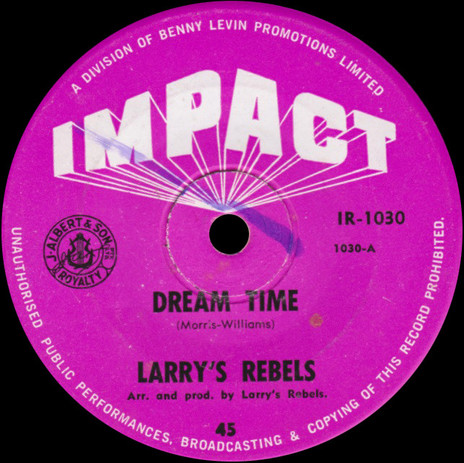
Larry's Rebels - Dream Time (Impact, 1967)
Of the other finalists, The Underdogs weren’t included on the tour, while Maria Dallas and The La De Da’s undertook their own national tours after returning from the US and Australia respectively. Many of the touring party had been involved in the just-completed C’mon six-week national tour.
Larry’s Rebels joined the tour after arriving back home from Australia in time for the fourth show in Hawera where they debuted their new fluorescent suits and unleashed their new strobe light show to an unsuspecting crowd, which the local press described in their headline as “PSYCHEDELIA IN HAWERA”.
The Avengers were the newest group on the tour; their debut single and Loxene finalist ‘Everyone’s Gonna Wonder’ debuted on the national Top 20 as the tour began. Although they had been together for over a year this was their first major tour with other acts. It was an enlightening experience and an indoctrination for them, as Avengers drummer Hank Davis recalls: “It was a fun tour all right but when Larry’s Rebels joined the fun-o-meter went through the roof. On one of their first nights with us, they started a talcum powder fight at the motel after the show. It finally finished with the whole place coated in powder along with a half a dozen completely white people. No one could be recognised, the tour manager and motel manager weren’t overly happy.”
Larry’s Rebels and their lighting effects immediately polarised the press wherever they went during the tour with some of the best and worst local reviews ever written – most, presumably, by older journalists:
Masterton: “Psychedelic lighting was featured by Larry’s Rebels. This proved very hard on everyone’s eyes. The lighting produced an eerie ghostly effect on stage, during which the Rebels jumped and gallivanted around. They appear to make better acrobats than singers.”
Hastings: “Recently back from Australia, Larry’s Rebels impressed bringing their new semi-psychedelic lighting device that flickered furiously while Larry gyrated in its dancing beams. The effect sought was obtained but tended to wreak havoc with the eyes of the audience.”
Napier: “The Rebels music was loud but well balanced. Glistening with perspiration, his coat and tie discarded and shirt open, Larry Morris led his Rebels from the stage to close the first half and left the second-half acts with a standard that proved to be too high.”
Nelson: “Psychedelia, the artificial evoking of the sensations of a drug ‘trip’ has taken over New Zealand’s top pop world. A large audience was convinced last night that the most skilful exponents of the style in New Zealand at the moment are Larry’s Rebels. Larry Morris and his Rebels ground their way through an act of blinding visual and sound impact.”
Rotorua: “With a wave of his finger, a lifting of an eyebrow, Larry was in full control of his audience and with frightening success raised their yells to frenzied screams of appreciation.”
Auckland: “While overseas pop groups like the Who and Jimi Hendrix Experience break their drum kits and explode their guitars and amplifiers on stage, Larry’s Rebels, with their sound and whirling psychedelic lights above the stage, are not far behind.”
Mr Lee Grant, who had been closing the show, was invalided out of the tour during the final week.
Ray Woolf: “When Lee left the show, we all moved up the pecking order and Lee Grant mania was replaced with Larry’s Rebels mania. They were the stars of the show, although we all had our own time in the sun. I consider them to have been at their absolute peak at this stage, they were on fire. Just back from Aussie in their coloured suits and opening with ‘Purple Haze’ in complete darkness, just John’s guitar intro ‘DAH DAH DAH DAH’ – then ‘bang!’ the lights start and Larry and the rest of the guys explode in a sea of flashing-pulsating lights.
“There hadn’t been anything like it in the country before. There were a few shows where they didn’t get past the first couple of songs. I think it was Dunedin where the fans completely obliterated the orchestra pit trying to get to the stage. End of show. The cast and crew would put bets on to see how many songs the group got through before the show had to be stopped. I think four was the average. There was never many police or security and we would all have to run the gauntlet to and from the bus, which was always chaos. If there wasn’t much security, family friends and crew would have to help form a barrier for us.”
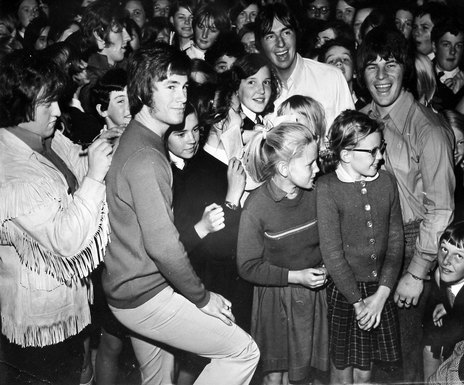
Larry's Rebels signing autographs with a very young crowd, venue unknown - Phil Warren Collection
Extra police reinforcements were urgently sent to the Wellington show. The Dominion reported the next day: “Larry’s Rebels proved too much for some over-enthusiastic youngsters and order was not restored till the arrival of extra police”.
The evening performance in Nelson’s Majestic Theatre saw 200 female fans storm into the orchestra pit where Larry managed to appease the crowd by throwing ties and a drumstick to them.
Further mayhem awaited Larry’s Rebels in a supposedly conservative Invercargill. At the end of the night the Rebels exited out of the rear entrance, only to find what looked like the town’s entire teenage female population waiting for them. The band quickly retreated back to the rear entrance where they remained safe, but the stage doors were damaged beyond repair.
Russell Clark: “Kerridge Odeon blamed us for the Rebels fans breaking the door to get backstage and took the repair costs out of the band’s fee. I remember having quite an argument with them and I made sure we at least got some publicity out of it!”
The Loxene Golden Disc for 1967 was awarded to Mr. Lee Grant for his record ‘Thanks To You’ at a presentation on November 4 while at the same event the APRA Silver Scroll for the best local composition was awarded to Roger Skinner for ‘Let’s Think Of Something’.
At the end of the year the group released their 4-track EP, Larry’s Rebels Sing Christmas Songs with proceeds donated to the Auckland Star-sponsored Christmas Cheer Fund, which was set up to help 5000 needy pensioners.
Their new single ‘Fantasy’ failed to make the national charts even after positive feedback and excellent reviews. It did however feature on a number of the country’s regional charts. Both sides of the single were recorded at Stebbing studios in Auckland.
“We arranged for a few violinists and a harp player [from the Symphonia of Auckland] to play on ‘Fantasy’,” says Nooky Stott. “Only problem was that the harp wouldn’t fit through the door of the studio, so she had to play in the adjoining garage with me standing in the doorway giving her the cues.”
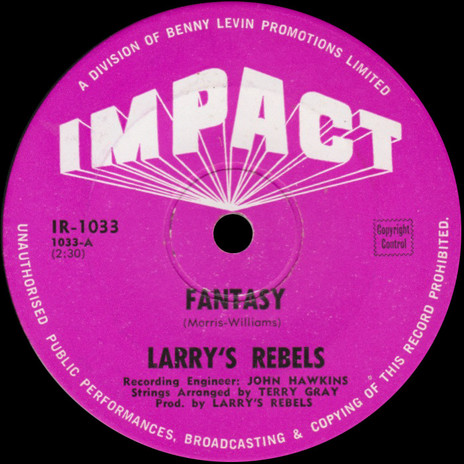
Larry's Rebels - Fantasy (Impact, 1968)
In a nice piece of ad-libbing, Larry recites Nooky’s name as one of the seven dwarfs in the fairy tale themed lyrics. ‘Fantasy’ was not released in Australia. “It’s not the sort of sound that the Australians go for,” revealed Russell Clark in the group’s March 1968 fan club newsletter. The B-side, ‘Coloured Flowers’, was also an original with John using wah-wah for the first time in the studio and Viv playing a Motown/Four Tops style bass line.
By early 1968 Larry’s Rebels were back in Australia, this time more as residents than visitors. They bought themselves new cars and moved into a block of three flats. Audience and press reactions continued to be highly favourable and the engagements became a lot more lucrative. In March they appeared before an estimated 240,000 people at the Moomba Festival at Melbourne’s Myer Music Bowl. Larry’s Rebels were third on the bill which included a smorgasbord of top Australian acts: Ronnie Burns, the Twilights, Johnny Young, the Master’s Apprentices, the Vibrants, the Young Ones, Lynne Randell, Somebody’s Image featuring Russell Morris, the Groove and Johnny Farnham.
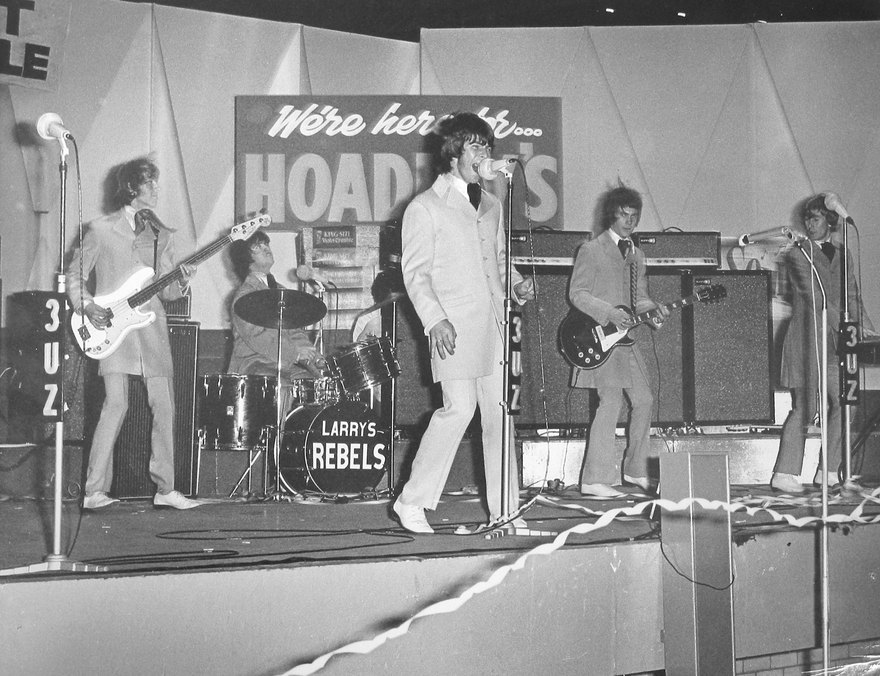
Larry's Rebels onstage in before 240,000 people at the Moomba Music Festival, Melbourne, in 1968. From left: Viv McCarthy, Dennis “Nooky” Stott, Larry Morris, John Williams and Terry Rouse.
Resplendently dressed in their fluorescent suits and equipped with orange and white smoke bombs, they virtually stole the show – along with The Groove, whose front line included Kiwis Peter Williams (ex-Max Merritt & The Meteors) and Rod Stone (ex-The Librettos).
Everybody’s magazine noted: “We’ve said it before, but The Groove looks like emerging as the group of 1968. But it was left to Larry’s Rebels to pull off the surprise of the night. They came on and the crowd went mad. We had heard that they were killing them back in New Zealand. We had been sceptical, but now we believe it.”
Top Australian disc jockey Stan Roffe proclaimed in the local press, “Larry’s Rebels completely stole the show with an absolutely sensational act that would rate as world class in any city in the world.”
Nooky describes the show. “We were unbelievably nervous before going on. Larry and John just sat there beforehand, as white as sheets, Terry was shaking uncontrollably and forgot to switch his organ on until halfway through the first number, while Viv and I were so wound up that we had to dash to the toilets after the final number to throw up.”
Viv McCarthy: “I can remember Olivia Newton-John and Bruce Welch [The Shadows] standing side-stage watching our set [they were an item at the time]. I couldn´t hear a bloody thing, the place just absorbed all the sound and there was no foldback in those days. I could just hear Nooky on drums next to me. The music came from memory and I had to watch Larry’s mouth for the vocal cues! God knows what it sounded like out front!!”
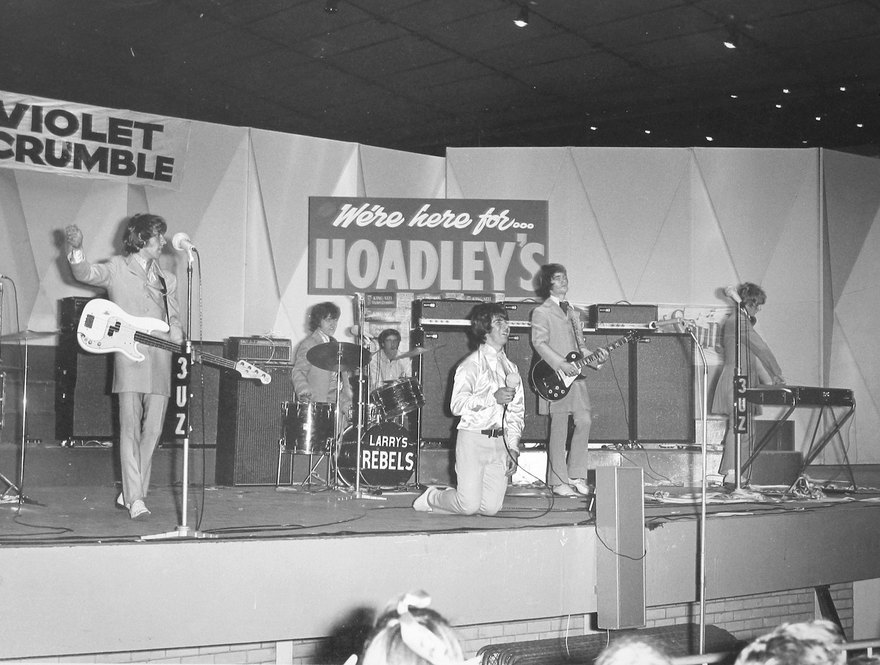
Larry the showman - taken at the Mowomba Music Festival, Melbourne, in 1968.
Impressed by the Rebels and wanting to help, Bruce Welch positioned himself in the front centre of the audience to keep an ear on the balance for the group, which humbled the group immensely, “Wow, someone as famous as Bruce didn’t have to do that for us, but he did,” commented an ecstatic Larry in the following day’s press.
After the hype and excitement of the Moomba Festival it was back to the nightly routine of the Melbourne club scene where their reputation continued to gather momentum.
At the same time they gained a lot of notoriety on the back of several well-publicised events. “LARRY’S REBELS A RIOT” proclaimed one headline. At inner city club the Opal, the group lit a few smoke bombs and an orange flare during their finale. The James Taylor Move took to the stage immediately after the Rebels and during their first song lead guitarist Kevin Peake changed colour and became violently ill from the fumes. He was rushed to hospital where he quickly recovered.
“It wasn’t that bad, everyone else was fine,” recalls John Williams, “he bad-mouthed us around town for a couple of months after that.”
No sooner had the smoke settled on this, another headline graced the news and music papers: “POP GROUP CHARGED”. This time the group were playing a lunchtime gig at The Trip, another inner-city club. Council officers approached the manageress and told her that there had been complaints from several retailers and the group would have to stop playing. The group took no notice and continued.
No sooner had the smoke settled than another headline graced the papers: “POP GROUP CHARGED”.
Ten minutes later the council officers returned with several police officers who immediately issued the group with a hefty fine for disturbing the peace and being public nuisances. The reporter overheard Larry politely telling the officers that the fine would have to go through their manager in New Zealand, to which the officer told him “don’t be smart” ... end of conversation.
On the recording side, EMI wanted six to eight songs in the can from the group by mid-year before their producer David Mackay was due to leave for a short transfer to EMI’s head office in the UK (where he would produce The Fourmyula single ‘Lady Scorpio’). Larry’s Rebels recorded the Hans Poulsen song ‘Everybody’s Girl’ and the group’s own ‘Halloween’ as singles, along with a long-lost psychedelic group composition tentatively titled ‘Mr Man’, complete with a Les Paul-styled backward tape intro. All tracks were recorded at Armstrong Studio in Melbourne.
With a heavy work schedule and very little time to themselves to write, the group struggled to submit more material. The idea of releasing ‘Halloween’ and ‘Everybody’s Girl’ as separate singles with album tracks making up the B-sides was considered by most as the best way forward. But EMI decided to release both songs on the one single in an all-out bid to crack the Australian charts (previously their singles were only regional state hits). EMI spent $250 on a star-studded launch party for the record and again the single only charted in a few states; in New Zealand it reached No.6 during July.
The group was back home in June and July to headline the national Blast Off 68 Pop Spectacular tour along with Australian singer Johnny Farnham, who was enjoying his second Top 10 record in New Zealand during 1968 (‘A Friday Kind Of Monday’) along with other popular local acts The Hi-Revving Tongues, Gene Pierson, Ray Woolf and Mike Durney.
A highlight of the Rebels show during this tour was the use of flares and orange smoke bombs in New Zealand, which had become a big part of their Australian shows. The group were now including the recent Eric Burdon & the Animals track ‘Sky Pilot’ into their act. As the song ended a sound collage of explosions and fighter plane sound effects would be competing with guitar feedback from the group. Larry would set off the flares and smoke bombs while Terry would emerge through the smoke playing his bagpipes and wearing his family tartan.
One show in Hamilton didn’t go as expected. Larry: “We had trouble getting supplies of flares. The only thing I could find was an emergency flare which I obtained from a ship chandler in Hobson Street. They filled the hall with smoke in seconds and proved to be toxic. The show was quickly closed down and the hall emptied due to smoke inhalation problems.”
Soccer mad, Larry, Ray Woolf and Johnny Farnham soon had the touring party sorted into opposing teams. The coach driver was instructed upon entering every town to find a suitable field to play on.
The fun of the tour was soon tempered with the announcement from Terry Rouse that he would be leaving the band after the final show of the tour in Palmerston North. “After six years I just felt that financially I wasn’t getting the rewards for the long hours. I was getting a good average wage of $70 but with a lot of expenses I was struggling to break even, plus I felt that at 21, I was getting a bit old for it.”
Viv McCarthy recalls a poignant moment for the group. “The tour bus arrived back in Auckland at tour’s end and there were Terry’s mum and dad waiting to pick him up. This was the official leaving of the group, it was hard.”
BENNY LEVIN TOOK terry rouse ASIDE AND DEMANDED ABOUT $500 allegedly owing.
Terry soon slotted back to normality but was also left with an unpleasant aftertaste after leaving the group. “I had to move back with Mum and Dad and I started a new 9 to 5 job. Two weeks later I arrived home from work, it was a Thursday, which was payday, and there’s Benny Levin having a nice cosy little chat and cup of tea with Mum. After a few pleasantries we excused ourselves. He took me aside and gave me a list of monies owing to him from me. It was about $500 that he demanded, including my portions of recording fees, overweight baggage and numerous other things.
“As far as I was concerned I owed him nothing and I told him so, he left and I thought that that would be the end of the matter. I arrived home on the next payday and here he is waiting for me and again having a nice chat with Mum on the premise of a social visit to see how I was getting on. Again he took me aside and asked for money, I told him again that I owed him nothing and off he toddled again. The next week, lo and behold, the same scenario, so I took him outside and between clenched teeth reiterated that I didn’t owe him a cent then thrust my pay packet at him which was about $100 and told him that that was all he was getting and to bugger off and leave my mum alone as well. I never saw him again.”
After hearing Allison Durbin’s new single ‘I Have Loved Me A Man’ the group realised that the only way to have a chance at winning the Loxene Golden Disc award was to record a ballad as their next single. They recorded the Jimmy Webb song ‘Do What You Gotta Do’ with keyboardist Brian Henderson filling in for Terry. The single was engineered by Wahanui Wynyard at Astor Studios.
‘Do What You Gotta Do’ entered the national chart on 12 September 1968 and peaked at No.6. It was nominated as a Loxene Golden Disc finalist, though it lost out to Durbin’s ‘I Have Loved Me A Man’.

" Vote for Larry's Rebels" - 1968 Loxene Golden Disc entry, 'Do What You Gotta Do'.
Released at the same time as ‘Do What You Gotta Do’ was a free disc titled ‘Party Time’ which was a personal message from the group to their fans, while the other side featured two excellent Coca Cola jingles which were written and produced by Wayne Senior. The offer of a free disc was announced on radio on the Saturday – listeners were directed to clip a coupon in the Sunday News – and a few days later all 3000 copies were gone. Several interesting trends emerged from the exercise, including the large number of older fans (older in those days would have meant anyone over 21) and also the proportionally large amount of requests from the West Coast and southern South Island.

Larry's Rebels, Playdate.
A short time later Mal Logan, ex-the Green & Yellow and The Look, was recruited as Terry’s replacement. Mal was first up at the audition and impressed the Rebels so much that they hired him on the spot and sent the other 10 candidates away.
The local music scene went into shock early in the new year when Larry suddenly left the group in the new year while on tour with Allison Durbin and just as their latest single ‘Mo’reen’ – also engineered by Wahanui Wynyard – was heading up the charts.
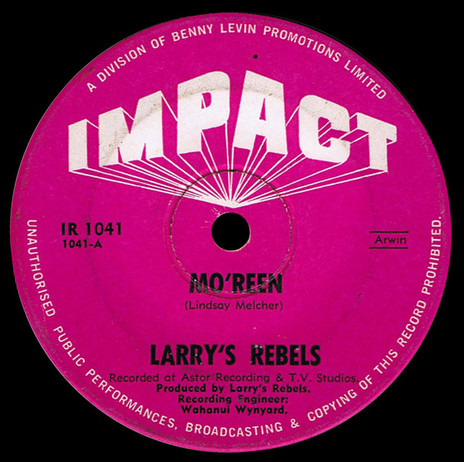
Larry's Rebels - Mo'reen (Impact, 1969)
“The tour rolled up to Whitianga,” recounts Larry. “It was the middle of summer and our accommodation was the tour bus, which was parked behind the outside stage with no amenities – we had to use the nearby public toilets for showering and changing. I saw red and set off to find our managers, Benny and Russell. I eventually found them in a nearby motel – air conditioned – and told them that we wanted a room just like this ‘or I was leaving’. Their reply was, ‘well there aren’t any rooms available and you wouldn’t leave anyway’. I think my last words were, ‘well, watch me’ as I stormed out of their room.”
Larry managed to cadge a lift back to Auckland. The remaining Rebels took to the stage that night without missing a beat with all vocals intact, and they completed the remaining dates on the tour without him.
The Rebels often rehearsed without Larry, in case he ever was unable to perform. He had a long history of injury after being pulled from stages and mobbed by fans on both sides of the Tasman. They reverted back to their original pre-Larry name of the Rebels and eventually added vocalist Glyn Mason, formerly from high profile bands such as the Roadrunners and The Bitter End. Members of the group already knew Glyn and were hesitant in approaching him for fear of breaking up his current band Jigsaw, but to their relief Jigsaw were in the process of disbanding anyway.

The Rebels, post Larry: Mal Logan, John Williams, Glyn Mason, Nooky Stott and Viv McCarthy.
The Rebels were generally applauded for signing Glyn by an educated public and media fraternity, most of whom were aware of the powerful vocalist. They always intended to replace Larry but reviews of their shows and comments from other artists at the time queried whether they should bother getting another singer, such was the vocal competency of the group. One of the reasons for the group’s success was the full vocal sound and complex harmonies from the other members complementing Larry, with Viv covering the high parts, Nooky the high and mid-range, while John covered the lower notes.
The first single from the new line-up was ‘My Son John’ which was backed with the impressive group composition, ‘Passing You By’. Such was the swiftness in recording and releasing ‘My Son John’ that it raced past their previous single ‘Mo’reen’, which was heading back down the national charts.
Indications were that it could become their first local No.1 record so they decided to stay home and promote it, which meant that they had to cancel their appearance at the 1969 Moomba Festival, where they had reigned supreme the year before. It eventually reached No.1 on the New Zealand charts in March, 1969.
Work also started on a long awaited album, only a year overdue, again with Wahanui Wynyard engineering. Viv McCarthy reflects: “Madrigal was done in a bloody rush, we were due to go to Australia in a couple of days. Most of the tracks were from our live shows as we had just spent four weeks at Snoopy’s in Christchurch and we were as tight musically as we had ever been. Mal did the best he could with an old Lowry organ but it sure as hell wasn’t a Hammond! That was the first thing we bought when we got back to Melbourne.”
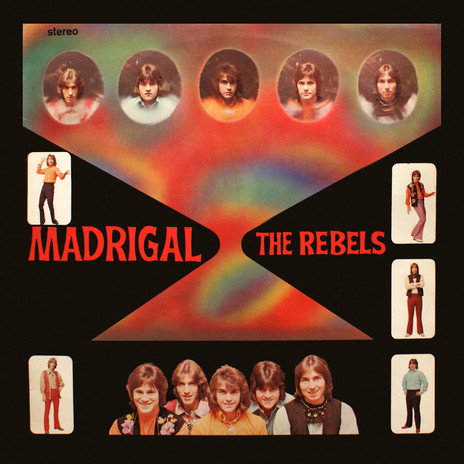
The Rebels' album Madrigal, recorded by Wahanui Wynyard in two days.
By the time the album was released, the Rebels were back in Melbourne for what was to be initially a four-month stay but ended up being nearly a year. The Rebels quickly settled into their hectic gig schedule in Melbourne, which was broken up with frequent tours out of state. In an article in a Melbourne newspaper on 21 January 1970, the group painted a positive picture for their future while lamenting their frustrating dealings with record companies, who were trying to coerce them into becoming a Top 20 covers pop group.
They saw their future in original material and after several false starts with a few labels they signed with veteran Australian producer and A&R man Ron Tudor, who had just set up June Productions; this soon evolved into the successful Fable label in April 1970. “He takes more personal interest in his artists,” the group were quoted as saying. The article went on to highlight the Rebels’ excitement about their upcoming single, ‘Can You Make It On Your Own’ b/w ‘I Can See The World’, both original songs written by the band.

Larry's Rebels - Can You Make It On Your Own (Impact, 1970)
A week after the article the group announced in a short statement that they were breaking up. Viv had married in the new year and it seemed like the perfect time for the band to break up. While comradeship was still high, the old Rebel spark had gone.
Viv, Nooky and Mal all returned to New Zealand while John stayed in Melbourne and Glyn joined the Chain, an established heavy blues band. ‘Can You Make It On Your Own’ was released posthumously. It entered the Melbourne chart on 14 March, 1970 and peaked at No.23.
It had been a long eight years. Perhaps Nooky summed the situation up the most poignantly. “I ended up living back home with Mum and Dad, with 50 bucks in my pocket, no job, a pair of drum sticks and a suitcase full of frilly stage clothes.”
--